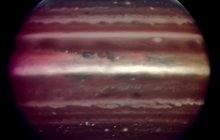MAD
The ESO Multi-conjugate Adaptive optics Demonstrator
 Just after the turn of the millennium, adaptive optics (AO) at Paranal Observatory was a novel technique with many challenges ahead: the second generation of the Very Large Telescope instrumentation and the Extremely Large Telescope. AO systems installed on 8-metre-class telescopes worldwide needed to evolve to face similar challenges. Most of the ground-based adaptive optics imagers were single guide star systems, which have very small fields of view with strong variations in resolution over this field.
Just after the turn of the millennium, adaptive optics (AO) at Paranal Observatory was a novel technique with many challenges ahead: the second generation of the Very Large Telescope instrumentation and the Extremely Large Telescope. AO systems installed on 8-metre-class telescopes worldwide needed to evolve to face similar challenges. Most of the ground-based adaptive optics imagers were single guide star systems, which have very small fields of view with strong variations in resolution over this field.
That is why ESO decided to build an adaptive optics instrument called Multi-Conjugate Adaptive Optics or MCAO. The ESO engineers and astronomers began by building an instrument called MAD or the Multi-conjugate Adaptive optics Demonstrator. The idea was to create a system capable of reconstructing the vertical distribution of the turbulence in the atmosphere by observing several natural guide stars at the same time. These different layers of the atmosphere were analysed using wavefront sensors and then corrections at different altitudes above the telescope are applied by optically conjugated deformable mirrors. Ultimately, a detailed correction was obtained for the atmospheric turbulence over a wider field of view.
 Installed on the Nasmyth focus of the VLT Unit Telescope 3, or Melipal, MAD was used in three technical runs from March to September 2007, and then three science demonstration runs from November 2007 to August 2008. The final results were published in dozens of papers — a very productive campaign considering the short time. “Thanks to the high quality of the (unplanned) science results, the importance and high performance of the MCAO techniques for certain science projects, such as studies of stellar populations in globular clusters, was proven”.
Installed on the Nasmyth focus of the VLT Unit Telescope 3, or Melipal, MAD was used in three technical runs from March to September 2007, and then three science demonstration runs from November 2007 to August 2008. The final results were published in dozens of papers — a very productive campaign considering the short time. “Thanks to the high quality of the (unplanned) science results, the importance and high performance of the MCAO techniques for certain science projects, such as studies of stellar populations in globular clusters, was proven”.
“MAD was a prototype, an instrument built to test novel MCAO techniques and their performance on-sky. It used already-proven technologies for hardware and software”, clarifies Paola Amico, the ESO Astronomer who was in charge of operating MAD on the sky. The person responsible for developing the MAD project at ESO was Enrico Marchetti.
ESO also established a collaboration to develop the key components. An Italian consortium formed of the Observatories of Arcetri and Padova with the Italian National Institute for Astrophysics (INAF), developed the novel concept of a wavefront sensor used in what is known as “Layer Oriented” mode, and the instrument control software. A consortium led by Universidade de Lisboa (Portugal) was responsible for developing the Camera for MCAO, or CAMCAO, which was used by MAD to evaluate the correction performance.
At the end of the last science demonstration, MAD was decommissioned and moved back to Garching, where it has been used for laboratory tests. The experience gained with MAD was crucial for the AO systems at the Paranal Observatory.
MADThe authoritative technical specifications as offered for astronomical observations are available from the Science Operation page.
|
